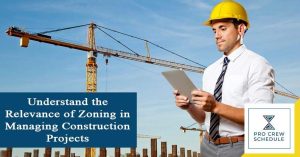In managing construction, zoning refers to regulations set by the government that guides contractors on what can and cannot be built on any given property. For any project, you can refer to the municipal, local, or city zoning maps to determine what zoning category your construction site belongs to. From that, you can discover the regulations for that particular zoning classification.
Zoning categories or classifications involve residential, commercial, industrial, agricultural, hotel, and other specific designations. Learn more on this below.
What are Zoning Classifications?
After learning what type of structure you can build—for instance, a mid-rise condominium building or a single-lot bungalow house—the zoning ordinances for your zoning classification will include the construction requirements. Zoning laws will regulate details in specific construction locations. For instance, it can limit the maximum floor area of your building in a given location regardless of the type of construction allowed.
Zoning ordinances require the minimum area of a lot you need to build your construction project detailing dimensions like depth, width, and street frontage. Each of the three regulatory requirements must be fulfilled in order to receive approval to build your desired structure. Zoning requirements also require the minimum distances or setbacks in the perimeter of your property line that should remain structure-free. Fencing, outbuilding, decking, floor area ratio, and coverage also fall under zoning regulations.
What is the Relevance of Zoning in Construction?
Since zoning laws regulate the details of a construction project based on its location, it is essential to reinforce your planning structure with zoning details of the lot. However, construction managers always make the rookie mistake of forgetting to integrate zoning into their planning.
As zoning regulations dictate the size, density, and location of structures within a perimeter of the land, along with green space parking and requisites, it is essential to incorporate the data they defined into your construction planning and scheduling.
a. Size refers to the footprint, number of stories, total height, etc., of a building structure.
b. Density relates to the construction development allowed per square meter, dictated by the total number of housing units per land parcel (for residential development) or floor area ratio (in commercial development).
c. Location – lastly, this is regulated by the minimum open space allowed around a building or structure (commonly known as setbacks). Considering all these and plotting specifications into the general construction plan and the overall schedule would streamline jobs and tasks logically and systematically. Incorporating construction scheduling software and tools can help establish these workflows easily.
What are the Types of Zoning Codes in the Construction Industry?
Since we already know that zoning classifications dictate what a specific piece of land can be used for, let’s take a glance at some of the most commonly used in the construction industry:
1. Residential
With all the different types of dwellings that people call home nowadays, a municipality would usually have multiple residential districts that can quite a bit depending on the types of residences inhabiting them. The main factor often deals with whether the districts are made up of single-family homes or multiple ones:
a. Single-family homes – typically what you picture when you think of a house: a lone building that is home to only one household or family.
b. Multifamily homes – these are dwellings that are inhabited by more than one family or household (think compounds, townhomes, duplexes, or apartments).
The rules that govern residential structures would differ depending on the specific type of residential district you’re in. For instance, a single-family home in a more isolated subdivision will have different zoning requirements than a high-rise apartment building in the heart of a busy city.
2. Industrial
Areas zoned for industrial uses are those businesses that deal in light, medium, and heavy-scale industries. This can range from smaller real estate properties and mid-sized facilities to large, heavy-duty manufacturing warehouses. Generally, the heavy industry will be placed far away from residential spaces.
3. Business
Also known as commercial zoning, these places are where a city’s business districts place the shopping centers, office space, restaurants, and other places where locals, or even tourists, go to earn and spend their money. The proximity of a business zone to different zones would depend on the types of businesses in the local area and the amount of vehicle traffic those businesses typically draw. Restrictions may have been imposed on business district buildings, such as a minimum setback, maximum building height, or a requirement to provide parking.
4. Institutional
These zoned areas usually include libraries, museums, publicly owned recreational facilities, schools, or places of worship. What can be considered an institutional structure can vary depending on one’s locality.
5. Agricultural
Whether a municipal will have an agricultural district will depend on whether the area has a farming industry to begin with. Agricultural zoning is meant to protect farming lands from adverse land uses that could harm them and give the farms the space they need to run effectively and efficiently.
6. Mixed-Use
Mixed-use zoning authorizes multiple uses in one district that have been deemed compatible with each other. The types of mixed-land uses that are approved will depend on what a municipality has decided is acceptable. In some mixed-use zoning, you will see downtown areas where structures will have residential units on the upper floors and retail on the ground storey.
7. Planned Unit Development
This zoning designation allows for flexibility when a zoning ordinance of a municipality didn’t plan for but benefits the locality as a whole. Some of the designed unit development examples are ski resorts, where you’ll see outdoor open spaces, hotels or transient rental properties, stores, restaurants, and other types of development all within a single space of land.
8. Open Space
In some cases, a community’s zoning ordinance will require open space zoning to protect its undeveloped land. This can include spaces like playgrounds, parks, and vacant lots.
9. Historical
In places with lots of historic structures or close landmarks or monuments, a municipality’s zoning ordinance may consider these neighborhoods and provide protections for those structures.
How Can Project Management for Construction Technology Help with Zonal Planning?
1. The designated subcontractor arrives at the construction time on the right date at the right time
Since zoning adds a series of conditions into your construction schedule, putting everything on subcontractor scheduling software can streamline your workflow of who needs to do what on a specific schedule. Real-time progress updates give your construction subcontractors a clear plan of what they need to do and when to show up.
2. Enhance schedule predictability with standardized systems
As you base your construction scheduling and planning on a set of strict standards, you can standardize your processes and create an effective work routine. This way, you increase productivity on repetitive tasks, minimize mistakes, and strengthen routines while making faster decisions for a successful overall outcome of your construction project.
3. Everyone on the project team stays on the same page with an overview of on-site progress
Having a live construction crew management platform that everyone can access anytime and anywhere allows all your project crew members to know what is precisely happening on-site at any given time. Real-time progress updates enable everyone to stay on the same page, inform relevant collaborators or stakeholders of their respective tasks, and encourage teamwork and accountability.
4. Minimize wasted resources, such as time and money
Since your work processes will be standardized, your workflows are pre-determined, your schedule predictable, and your construction progress is live, you can mitigate material and time waste before they can have any significant effect on your construction schedule—no more room for downtime and delays.
5. Keep your project margins always in mind
When you minimize time and materials waste, you also eliminate unnecessary downtime and delays—waiting or transition time between activities will also be eliminated. Moreover, as you detect mistakes and communicate them promptly, you mitigate project misunderstandings and significantly reduce all related legal disputes and claims. Ultimately, you ensure that your project margins are kept intact in the whole lifecycle of your construction process.
Key Takeaway
Now that you understand the definition of zoning, its relevance in the industry, the different zoning classifications, and how its regulations can dictate the series of workflows in your construction process… maybe this is the sign you need to start integrating zoning into how you devise your project plans and overall look-ahead schedules.
If you are interested in combining all these zoning learnings and using construction scheduling software to optimize how you and your crew work, Pro Crew Schedule is here to help. Enjoy all the perks of construction technology mentioned above, from preparing your zonal plans and schedules to managing your construction projects successfully to completion.
See how Pro Crew Schedule can help your business. Start your 30-day free trial today.







